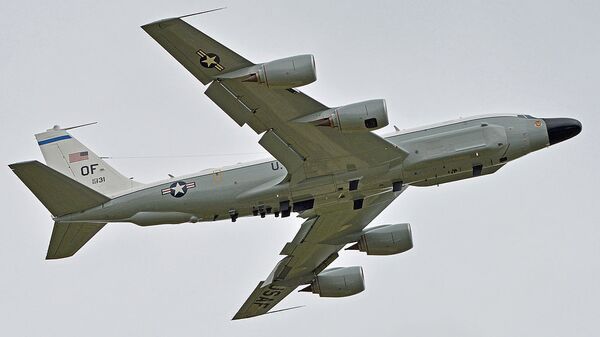According to the South China Sea Probing Initiative (SCSPI), a Chinese think tank connected to Peking University, a US Air Force RC-135W Rivet Joint signals intelligence spy plane was spotted departing Kadena Air Force Base on Okinawa, Japan, on Tuesday, only to be mysteriously replaced by what seemed to be a Malaysian aircraft over the South China Sea.
Once the plane crossed the South China Sea, it then “patrolled intensively” over the international waters between Hainan Island and the Paracel Islands, the latter of which the US has challenged Beijing’s claims of sovereignty over, SCSPI said.
>>>Suspected US Surveillance Plane in Disguise as a Malaysian Plane.
— SCS Probing Initiative (@SCS_PI) September 8, 2020
On Sep 8, USAF RC-135W (#AE01CE) departed #Kadena for a #SCS mission. Later on the same route appeared a "Malaysian Plane"(#750548), which entered the SCS and patrolled intensively between #Hainan and #Paracels. pic.twitter.com/2dfVy4844n
The think tank noted another RC-135W performed the same maneuver several days prior: broadcasting a nonsense International Civil Aviation Organization (IACO) hex code identifier while it patrolled in the South China Sea, but switching back once it entered the Philippine Sea.
Similar situation just happened a fews days ago.
— SCS Probing Initiative (@SCS_PI) September 8, 2020
On Sep 3, the very RC-135W was suspected of entering the #SouthChinaSea with the hex code #07675C, and left with #AE01CD. pic.twitter.com/Pvs5DcgW13
An aircraft’s hex code is part of its registration with the United Nations-run IACO and only changed rarely. The code identifies the aircraft in the sky, telling other planes as well as ground control what it is and where it is. While it’s common for military aircraft engaged in combat patrols to refrain from broadcasting such signals for fairly obvious reasons, the transponder serves as the bedrock of civil aviation safety, preventing collisions as well as misidentifications.
However, the practice of using fake transponder codes to disguise its spy planes is a common practice in the US Air Force. In 2019, several such examples arose, all of them involving RC-135W Rivet Joints, which monitor communications and other emissions across a broad part of the electromagnetic spectrum.
One incident on February 23, 2019, saw an RC-135W flying from Puerto Rico begin broadcasting a fake hex code as it flew close to Venezuelan airspace. The incident happened the same day as the infamous attempted forced crossing of the Tienditas Bridge by forces supporting the Venezuelan opposition, which claimed they were trying to bring humanitarian aid in from Colombia. Weeks earlier, US-backed opposition figure Juan Guaido had declared himself the country’s interim president and attempted to rally supporters inside and outside Venezuela to overthrow Venezuelan President Nicolas Maduro.
USAF RC-135W 62-4130 BEEF88 departed San Juan, Puerto Rico for a mission off the northern #Venezuela coast. The aircraft is using a false Mode-S hex code of '3F9857'. pic.twitter.com/1VD1BBdpjr
— Aircraft Spots (@AircraftSpots) February 23, 2019
In another incident on July 3, 2019, another RC-135W over the Persian Gulf switched its transponder code to an Iranian code as it flew laps inside Iranian airspace, even flying over Iranian territory in the form of two islands. Observers noted this trickery left an especially sour taste, as it came on the anniversary of the US shootdown of Iran Air Flight 655 in 1988, when the US Navy destroyer USS Vincennes shot down an Iranian airliner in international airspace, killing all aboard.
There are so many things wrong with what the #USAF is doing here, that are very much not evident to the casual observer.
— Steffan Watkins 😷 (@steffanwatkins) July 3, 2019
1) The RC-135 has changed its unique transponder number to 730000 (hex), an Iranian assigned code. So, the USAF is impersonating an Iranian plane. https://t.co/4zx5kdV3ua
Then, on September 23, 2019, a US Air Force RC-135U Combat Sent, a version of the plane specialized for radar monitoring, broadcast a fake New Zealand code as it flew close to Russia’s Crimean Peninsula.
— Manu Gómez (@GDarkconrad) September 23, 2019
However, that same day, an Iranian drone seemed to do the same thing as it flew through Emirati airspace, suggesting it’s not just the US that engages in this practice.
I honestly cannot believe that an Iranian UAV is currently fliying a few miles from Dubai and has not been shot down. Most likely Spoof Hex Code pic.twitter.com/1GAzgGGy7h
— Manu Gómez (@GDarkconrad) September 23, 2019
The confusion created by disguising military aircraft as civilian planes places innocent lives at risk, as incidents like Iran Air Flight 655 prove. An RC-135W was also at the center of another infamous airliner shootdown: when a Soviet interceptor shot down Korean Air Lines Flight 007 off the coast of Sakhalin Island in 1983, it was because Soviet radar controllers had mistaken the Boeing 747 for an RC-135W that was also patrolling in the area at the time and crossed flight paths with it.


